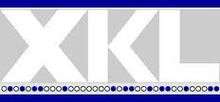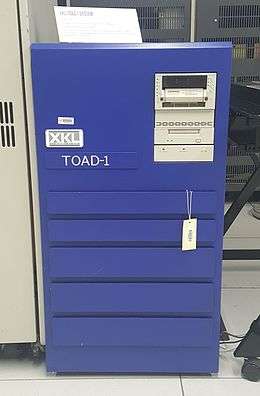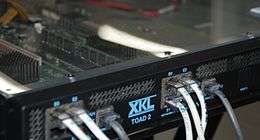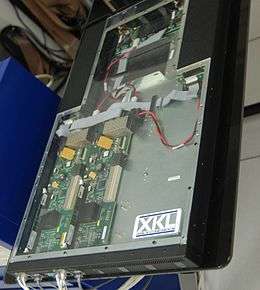XKL
Based in Redmond, Washington XKL, LLC, is an American company that develops optical transport technologies.[1] Founded in 1991, XKL is led by Cisco Systems co-founder Len Bosack who also used to work for DEC and Bell Labs. Under Bosack, Cisco commercialized local area network (LAN) technology to connect geographically to computers over a multiprotocol router system.
 | |
| Private | |
| Industry | Telecommunications Optical networking Computer Networking |
| Founded | 1991 |
| Founder | Len Bosack |
| Headquarters | , U.S.A |
Area served | Worldwide |
Key people | Len Bosack and Sandra Lerner |
| Products | Darkstar Optical Network Hardware |
| Website | www |
History of XKL
In its earliest days, XKL built a compact, modern replacement (TOAD-1) for a massive mainframe computer system (PDP-10) that had gone out of production. The challenge at the time was to find a mainstream usage for a totally new technology: a platform with a desktop-sized footprint, but incorporating technology that would bring the system into the 21st century.[2]
XKL deployed DarkStar technology that allows enterprises to take advantage of higher reliability and allow for more control over IT resources at a lower cost. The "plug and play" system allow data network engineers to deploy their own optical transmission systems in metro, regional and long-distance networks.
Products

TOAD-1
The TOAD-1 System, also known as TD-1,[notes 1] was announced in 1993 and built as an extended version of the DECSYSTEM-20 from Digital Equipment Corporation. The original inspiration was to build a desktop version of the popular PDP-10 and the name began as an acronym for "Ten On A Desk". It was eventually built at XKL by veteran engineers from Cisco, DEC, Hewlett-Packard, and CDC.[3]


It was the first XKL product produced and it became available for purchase in late 1995. The TOAD-1 is a high-performance I/O oriented system with a 36-bit processor running TOPS-20. It is a 36-bit multi-user system that can provide service to over 100 users at a time. The TOAD-1 architecture incorporated modern peripherals, and open bus architecture, expanded physical and virtual memory while maintaining the TOPS-20 user environment.[1]
TOAD-2
The TOAD-2 was built to replace the TOAD-1. It was a single chip reimplementation used as redundant control processors in networking equipment from XKL. It could be configured for TOPS-20 timesharing.[3]
Darkstar DXM
First released in 2007, the Darkstar DXM was a high-performance optical switch first installed at the California Institute of Technology as part of their Supercomputing Bandwidth Challenge. It provided 5 times the bandwidth, in excess of 100 Gigabits/sec, than the existing system but was also smaller and used less power.[4]
Notes
- The TOAD-1 was referred to as the TOAD as a development codename and then changed to the TD-1 as the original marketing name. It was then swtiched back to TOAD-1 before production began.
References
- "XKL Flier". Retrieved 29 June 2016.
- "About Us – XKL". www.xkl.com.
- "Exhibits - Living Computer Museum". www.livingcomputermuseum.org.
- "XKL, LLC: XKL Supports Caltech in Supercomputing '08 Bandwidth Challenge". Internet Archive: Wayback Machine. 6 October 2009. Archived from the original on October 6, 2009. Retrieved 12 July 2016.
- Duffy, Jim. "Cisco founder wants to go faster, farther". Network World. Retrieved 2009-06-01.
- "Len Bosack and XKL introduce "Do It Yourself Optical Networking"". GLG Group. Retrieved 2007-08-08.
- "Cisco Founder Pushes for DIY Optical Networks". Light Reading. Retrieved 2009-07-03.
- "Len Bosack speaks with Erik Linask at ITEXPO". TMCNet. Retrieved 2010-10-06.
External links
- Official website
- Login into the Living Computer Museum, a portal into the Paul Allen collection of timesharing and interactive computers, including an operational XKL TOAD-2